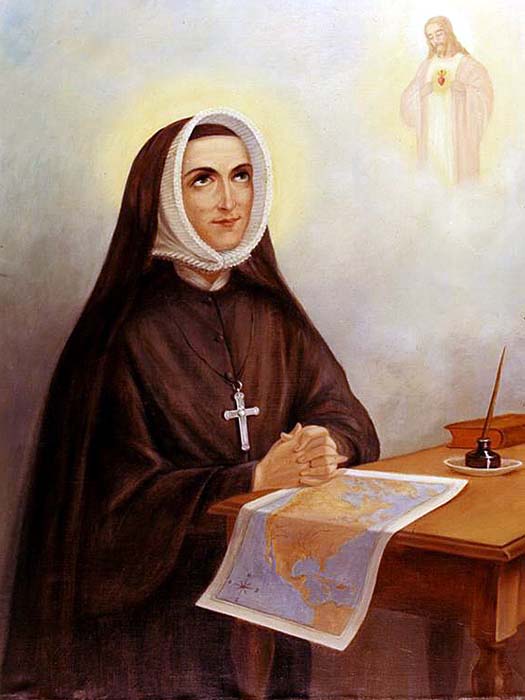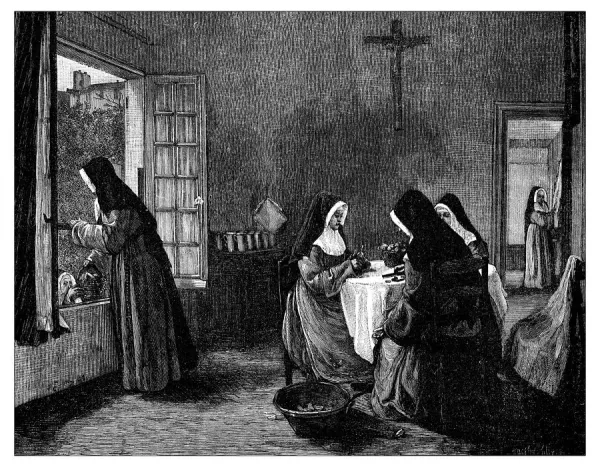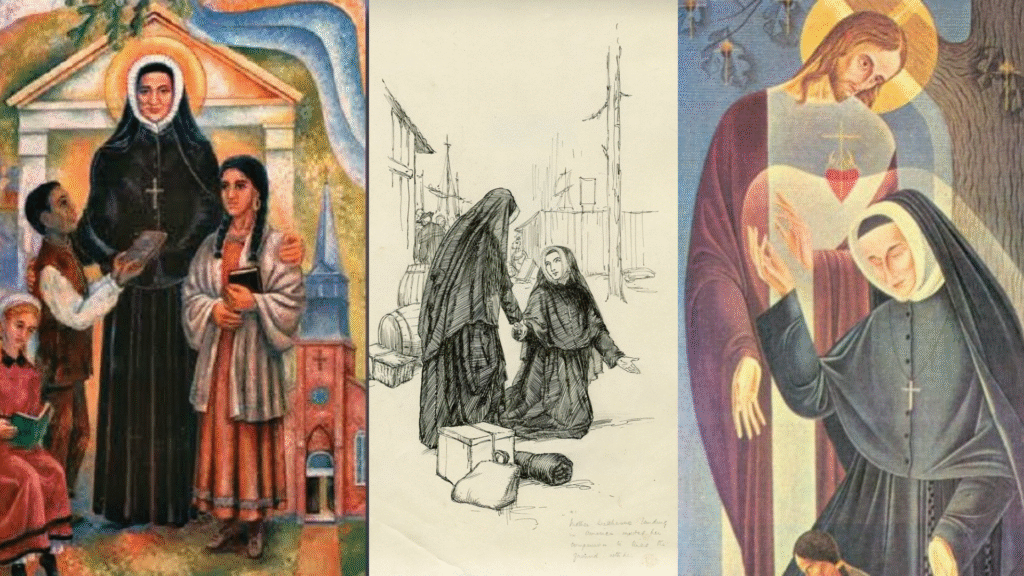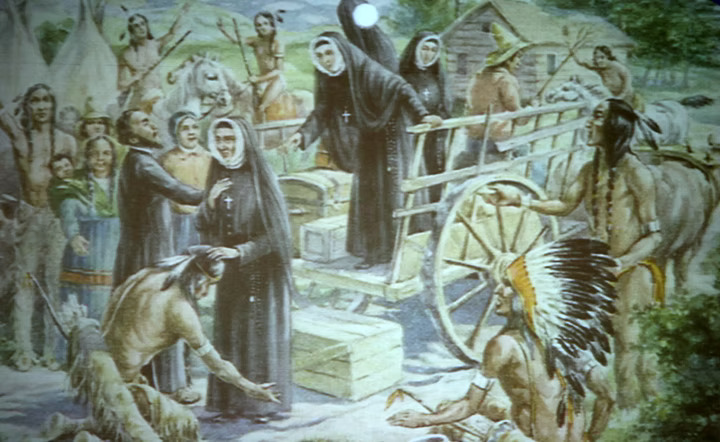

The Catholic Patriotic Minute #8: Saint Rose Philippine Duchesne
Catholics For Catholics Special Edition | August 25th, 2025
Saint Rose Philippine Duchesne: A Life of Obedience and Service
On August 29, 1769, Rose Philippine Duchesne was born and later baptized in Grenoble, France. Her parents, well-to-do and Christians, named her after Saint Rose of Lima, the first saint of the Americas, and Saint Philip the Apostle.
Beginning from her childhood, Philippine was known for her strong-willed nature. When she was supplied with money from her family, she would give it in full to the poor, announcing “[t]hat’s what I choose to do with it” unapologetically despite her family’s questioning. Her love for the vulnerable began at an early age. She loved reading about the saints’ lives, especially the stories of heroic martyrs. Tales of Rome’s rise and fall fascinated her, as did the accounts of missionaries. Specifically, Father Jean-Baptiste Aubert’s missionary life in the American South serving the Indians and French inspired Philippine to consider becoming a missionary.

With her cousin Josephine, Philippine often visited her aunts, who were nuns at Sainte-Marie d’en-Haut, a convent in Grenoble. Here, they studied at the convent’s boarding school and prepared for Holy Communion in 1781. After receiving this Sacrament, Philippine offered herself to God and prayed the Memorare multiple times a day for clarity of God’s will and for strength. When her parents discovered that Philippine was considering the contemplative life or the life of a missionary, her father, who dabbled in Masonry by this time, pulled her out of the boarding school soon after receiving the Sacrament of Holy Communion in 1782.
To her family’s surprise, Philippine submitted to her father’s wish for her to remain at home. She silently continued her daily meditations and devotions to the Sacred Heart and to the Holy Eucharist. She followed her family’s practice of participating in all social events and dances, until she turned eighteen. Determined to honor her vocation to religious life, Philippine declined her father’s wishes for an arranged marriage. One day in 1788, she embraced detachment from her family by swiftly entering Sainte-Marie d’en-Haut as a novice, without warning her parents. Philippine loved her family, but her love for her Heavenly Father was primary.
During her novitiate life, Philippine admired and prayed for the intercession of two saints: Saint Francis Xavier, the saint with the apostolate of missionary work, and Saint John Francis Regis, the saint with the apostolate of serving the poor. She practiced obedience to the rules of her convent, never breaking one. She took great joy in spending most nights before the tabernacle in silent adoration. Philippine was supposed to make her religious profession in September of 1789, but because of the religious suppression that began then, her father demanded that she wait until she was twenty-five to profess vows. The strong-willed Philippine obeyed.

When the French Revolution broke out a few years later, Sainte-Marie d’en-Haut closed down and Philippine temporarily went back home. After the Concordat of 1801, Philippine attempted to re-establish Sainte-Marie d’en-Haut, but in 1804, she let go of her previous order and entered the Society of the Sacred Heart of Jesus as a novice. To the foundress of her new community Mother Madeleine Sophie Barat, Philippine wrote about one of her nights of adoration on Holy Thursday, “I spent the entire night in the new World. . . carrying the Blessed Sacrament to all parts of the land. . . I had all my sacrifices to offer: a mother, sisters, family, my mountain! When you say to me ‘now I send you’, I will respond quickly ‘I go”‘.
In 1818, Philippine was finally asked to answer the call of missionary work in the Louisiana territory, just as Father Jean-Baptiste Aubert did, by serving and evangelizing the French and Indian. With little-to-no understanding of English and a lack of financial aid, she crossed the Atlantic with four other religious from the Society in France. On the Feast of the Sacred Heart, May 29, 1818, they arrived near New Orleans.

After establishing their first school in 1818 in St. Charles, Missouri, they established their first novitiate in the New World in 1820, in Florissant, Missouri. By 1828, Philippine established six schools for young women in Missouri and Louisiana. At the age of seventy-two, Philippine was asked to help the school for the Potawatomi in Sugar Creek, Kansas. The head of the mission asserted, “[s]he must come; she may not be able to do much work, but she will assure success to the mission by praying for us. Her very presence will draw down all manner of heavenly favors on the work”.
Because of the stories she heard about the severe suffering and poverty that the Potawatomi endured after being forced away from their homes in Michigan, Philippine repeatedly asked to join, even though she was extremely ill. Although Philippine was only with the American Indians for a year, her presence did make a mark, despite not being able to do physical labor and not knowing the Potawatomi language. Mother Mathevon, one of the sisters at this mission, wrote of Philippine,
She stayed all morning in the church, so Sister Louise would take her a cup of coffee each day, and she drank it at the door of the church. After dinner she went again for three or four hours of prayer. The Indians had the greatest admiration for her, recommended themselves to her prayers, and called her Woman-who-prays-always [Quah-kah-ka-num-ad]. Everyone admitted that a great number of baptisms resulted from her prayers. Almost every Sunday afternoon three or four men or women and all their families were baptized.

Recently, people tend to disregard the story of Saint Rose Philippine, because of her ties to slavery. When Philippine arrived in the United States, she initially was surprised at the existence of slavery because slavery was abolished in France in 1794. She did not approve of the practice. But, when encountered with the physical hardship that came from establishing the six schools in the West as well as the lack of servants for hire, these few religious did end up acquiring a few slaves. Participating in slavery can never be justified, but Philippine did regard them as servants. She tried to find ways for the slaves to enter their schools, which was a failed effort, and she taught catechism to over a hundred slaves, writing once that there were “some among them who live[d] like saints.”
Rose Philippine returned to St. Charles, Missouri in 1842 because of her illness, and later on November 18, 1852, she passed away at eighty-three. Philippine’s lifelong imitation of saints, such as Saints Rose of Lima, Philip the Apostle, Francis Xavier, and John Francis Regis, led to her becoming a saint herself. In 1988, Pope John Paul II canonized Saint Rose Philippine Duchesne. Catholics today make a pilgrimage to the National Shrine of Saint Rose Duchesne in St. Charles, Missouri, where her remains lie in a side chapel.
For more Catholic Patriotic Minutes, visit CATHOLICUSA.COM
Save and Share this Catholic Patriotic Minute!
